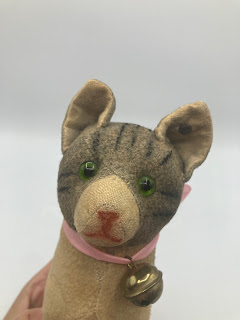Talk about a wow-wow-wow meow find! Steiffgal was handling a small collection for a new friend and came across this most unexpected item amongst a number of other button-in-ear treasures. According to the consigner, all of these precious childhood Steiff companions were purchased at F.A.O. Schwarz in the late 1950s and early 1960s. That information was good to know... but proved really invaluable in this particular case. Come learn more about this purr-fect Steiff rarity.
What we have here is a supersized Steiff Fiffy cat. She is lying, head jointed, and made from white mohair that has been carefully hand-airbrushed with black stripes. Her tail wraps around her rear in a most realistic way. She has green and black slit pupil eyes, and a pink embroidered nose, mouth, and claws. Her pink ribbon appears to be original to her. Steiff's standard line Fiffy cat was produced from 1955-1962 in 12, 17, and 25 cm. This Fiffy retains her button, ear tag, chest tag, and red wooden bell shaped F.A.O. Schwarz tag as her Steiff IDs.
Soooo... what's the big deal here? Well, this gal is UNUSUALLY large, and in fact is 30 cm. The largest one noted in the standard Steiff reference books is 25 cm. This example has a yellow ear tag which is numbered #2330.90. These digits translate to: 2=lying, 3=mohair, 30=size in cm, 9=special edition, and 0=normal or natural coloring. Given her dimensions, numbering, and presentation, it is Steiffgal's best thinking that this monumental Fiffy was produced as a special edition item for F.A.O. Schwarz in the mid 1950s to the early 1960s.
It was not uncommon for Steiff to make tweaks to popular standard line patterns and present them as exclusives to F.A.O. Schwarz in the 1950s and 1960s. So there is precedence for this unusual find. These modifications included things like size, coloration, body position, materials, or other design details. For example, Steiff produced standing or lying Dally Dalmatians (the standard line versions were sitting), a sitting black and white Cockie (the standard line version was standing), and an open mouthed Biggie Beagle (the standard line version had a closed mouth) as dog specials for F.A.O. Schwarz. And for the felines, the list is shorter, but equally intriguing. It is suspected that a pair of 8 cm, legless, curled up baby cats that appeared in F.A.O. Schwarz's "Kittens in a Basket" offering were based on Steiff's beloved standing Tapsy kitten design. These happy handfuls are pictured here on the left. Like the fabulous Fiffy under discussion here, the one with the open eyes also has a faintly legible ".90" at the end of her article number. Steiffgal hopes this discussion on this supersized Fiffy has really tickled your whiskers!
Have a question about one of your Steiff treasures? Let's talk! Click here to learn more.















































